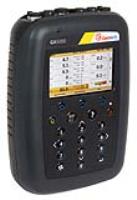 Add My Company
Add My Company
Sign In

Geotech's GA5000 landfill gas analyser is increasingly used on closed landfill sites as policies, including waste separation, take effect around the world, reducing the volume of waste sent to landfill. UK-based Exea Associates uses the GA5000 to maximum effect to understand the changing gas mix and pressures as landfill gas generation slows on a site.
Methane (CH4), carbon monoxide (CO) and oxygen (O2) levels are used to calculate the residual nitrogen (N2) level - the GA5000 can calculate this directly. "By looking at the N2 / O2 ratio in particular we can understand a great deal about how a landfill site is functioning. From the single data screen on the analyser we can get a good idea of what's happening underground and know what and where to investigate", explains Exea's director, Kieron Finney.
"We go beyond standard data gathering to interpretation and provide advice by looking carefully at gas readings, including avoiding underground fires, identifying a collapsed borehole or maximising energy generation". Exea Associates is also developing new investigative techniques using the GA5000, such as depth profiling in a borehole. Kieron explains: "Measuring the gas at the top of a borehole does not give the whole picture. As landfill gas is heavier than air and suction decreases with depth, the gas mix could be very different from the top to the bottom of a 50m well. First we dip the well to check the water level and then start sampling gas, using specially designed tubing, at 0.5m above the water surface. We can then take 50 measurements as we come up the well using the GA - all quickly recorded for download later. The GA is great."
Another example of changing gas mixtures is the increase in hydrogen (H2) levels seen on many landfill sites recently. The GA5000 is regularly used to monitor CO which can be used as an indicator of underground fires. However, H2 can interfere with the CO reading, even at low levels. The hydrogen-compensated CO sensor available on the GA5000 can correct the CO reading up to 10,000ppm of H2 and an indicator on the screen shows when H2 is at a level which may interfere with CO readings. Kieron is closely involved with the work done to understand changes in gas mix and continues to identify future trends which gas analyser manufacturers and landfill operators will both have to adapt to. "As we are now at the bottom of the 'landfill gas generation curve' for many sites in the UK", says Finney, "we are needing more negative pressure to extract gas. This can affect the gas mix or even directly cause a fire within the site. Such a fire can lead to huge financial problems from lost energy revenue - another reason to capture and carefully interpret gas readings from an older landfill site.
The GA5000 also helps with some practical challenges; Exea consultants find the GPS option very helpful, particularly on older landfill sites where the boreholes can be overgrown and very difficult to find. They also use the analyser's full data management facility, as Kieron describes: "We used to write down readings but now we download all the data, including other numbers, such as leachate dipping levels, which are entered straight onto the GA. We use the GAM software to create our own reports. We regularly gather 1,000 or more datasets so manual data collection isn't feasible. What would otherwise take 2 days can be achieved in 5 minutes by downloading data using the Gas Analyser Manager (GAM) software."
For more information on Geotech's GA5000 plays its part in the drive to reduce waste to landfill talk to QED Environmental Systems Ltd
Enquire Now
More News
List your company on FindTheNeedle.

